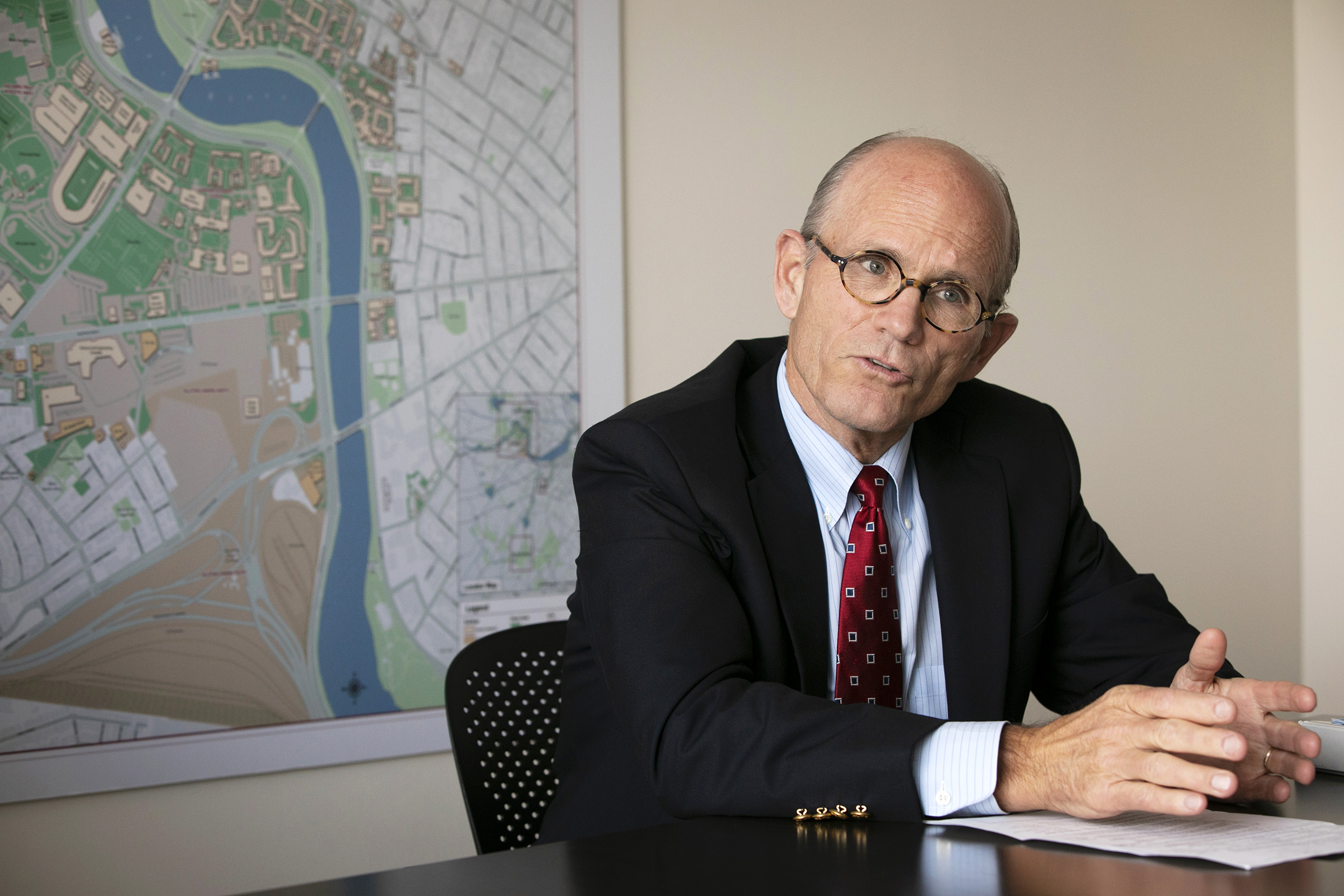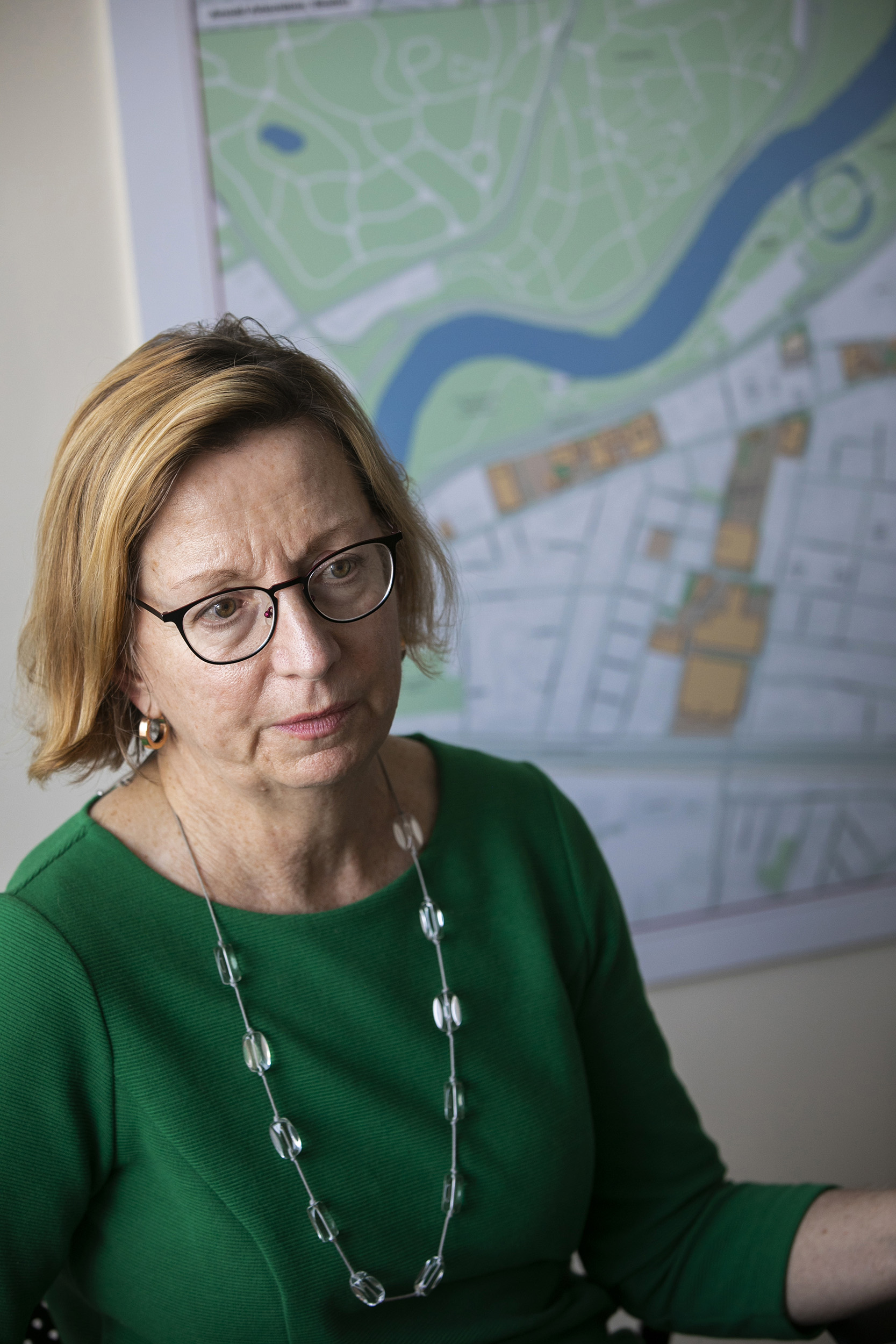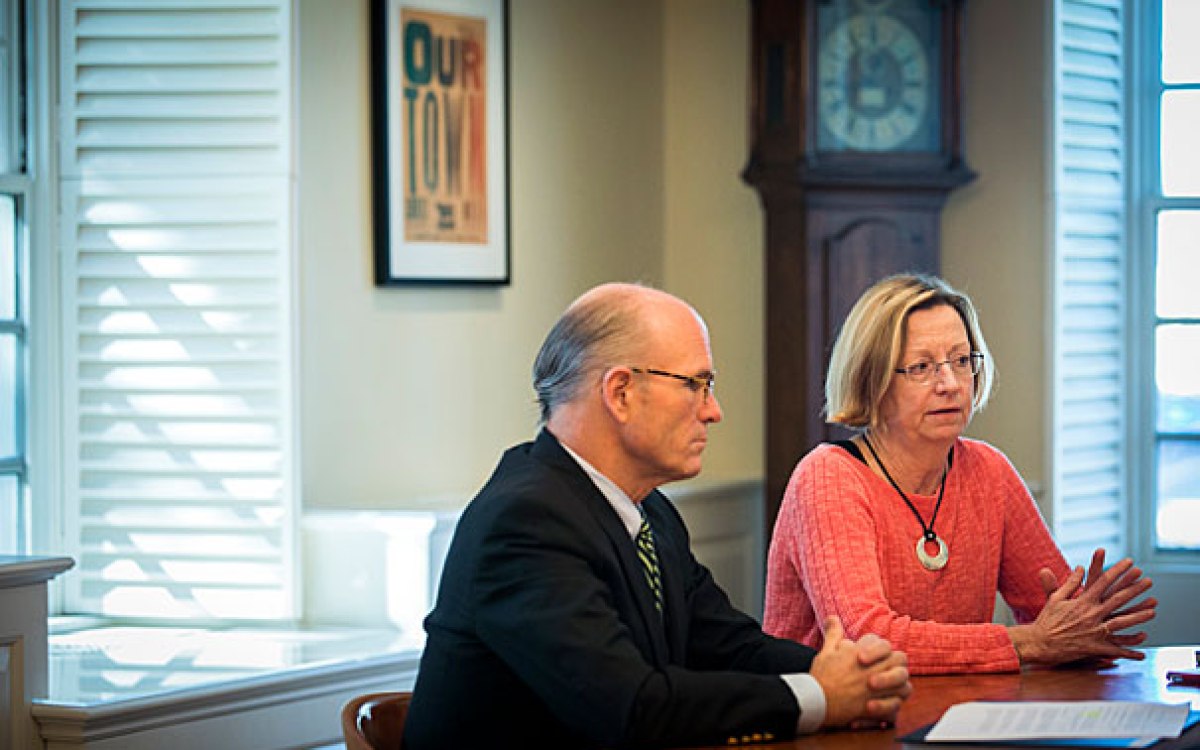
Vice President for Finance Thomas Hollister sits down with the Gazette to discuss Harvard’s budget and the last fiscal year.
Photos by Stephanie Mitchell/Harvard Staff Photographer
For Harvard, a look at the financials
Lapp, Hollister analyze the last fiscal year and discuss the challenges ahead
The Gazette recently sat down with Harvard Executive Vice President Katie Lapp and Chief Financial Officer and Vice President for Finance Thomas Hollister to talk about the University’s $5 billion budget and the 2018 fiscal year that concluded June 30.
Highlights of the budget year included higher-than-expected revenue from continuing education and non-federal research grants, as well as higher-than-expected contributions, through The Harvard Campaign, to current giving, which goes into the annual budget for areas like financial aid. Harvard ended the year with a surplus, which the University’s top financial officers credited to budgetary discipline and better-than-anticipated revenue in some key areas.
Lapp and Hollister praised the commitment to budget discipline by President Larry Bacow and the budgetary reforms installed under previous President Drew Faust. They also discussed the challenging higher-education landscape and cited Bacow, who in his inaugural address early this month said that universities have “been great at doing more with more,” but cautioned that in the future “we may have to do more with less.”
Q&A
Katie Lapp and Thomas Hollister
GAZETTE: The annual financial report looks back at the fiscal year that concluded June 30. What was the story of the year?
HOLLISTER: I would say this past year was a solid performance, with a surplus of $196 million and endowment returns of 10 percent.
GAZETTE: What factors led to the surplus?
HOLLISTER: The first thing I would highlight is careful expense management, across the entire University. Expenses grew year over year a little bit under 3 percent, which is important in this context because our sources of revenue were constrained. The endowment payout increase year to year was only 2 percent, federal funding was up only 1 percent, and net revenue from degree program tuition was up 3 percent. Those are slow growth rates for almost two-thirds of our academic and research revenues.
Then we had two or three areas that are harder to predict, and happily, at least this year, had good results. The first would be current giving, at $467 million, which was a record; nonfederal research funding increased 8 percent; and executive and continuing education grew 12 percent.
GAZETTE: How about financial aid? Obviously that’s an important priority for the University. How did that do?
HOLLISTER: That was, happily, up 6 percent this past year. Scholarship spending rose from about $561 million to $592 million, and overall aid rose to $703 million. At the undergraduate level, 54 percent of students last year were on financial aid, and on average they paid $12,000 for tuition, room, and board for a Harvard education. It is wonderful that these promising students can come to Harvard and, through our commitment to aid, they can attend debt-free. It’s really powerful.
GAZETTE: I’ve heard appeals for more current giving over the years. Why is that important?
HOLLISTER: There are three areas of philanthropy, all critical to the University’s success. First is gifts for facilities, the wonderful new buildings that have been built or renovated — we’re sitting in one of them, the Smith Center, today. Second is gifts to the endowment, which enable the expansion of teaching and research for years to come. Third, current giving is critical because it represents approximately 10 percent of revenue annually, and it goes right into funding operations. Without the remarkably generous support from alumni and donors, it’d be very hard to offer all of the financial aid, research, and teaching that Harvard offers.

More like this
LAPP: I would like to add to what Tom said about expense control throughout the University. It really is a testament to the deans, their administrators, President Faust, and now President Bacow that they focused on controlling expenses. We’re going to have to continue to make choices about how we deploy our resources, whether it’s financial aid, whether it’s new buildings, whether it’s hiring more faculty or staff, or bringing in more students. The FY18 results indicate that throughout this University people are focusing on how to control expenses so we can deal with some of the challenges facing higher education.
On the facilities side, what the campaign has done is allow us to raise money for new buildings — Klarman Hall just opened at HBS (Harvard Business School), an amazing facility — and to take the existing facilities and renovate them to bring them up to 21st-century standards. We’re in the Smith Campus Center, which is an extraordinary renovation of an old structure that brings it into the 21st century as the capstone of President Faust’s Common Spaces initiative.
Andover Hall is going to be renovated over at the Divinity School thanks to philanthropic support. House renewal continues apace, and Lowell House, which is under construction now, is still on schedule to be open for the next academic year.
So a lot of focus in the campaign has been to take care of what we own, address deferred maintenance, and build new facilities where warranted.
GAZETTE: We have spoken about the importance of controlling expenses over the past few years, about implementing best practices and budgeting structures. Are we getting better at it? Is there a learning curve?
LAPP: I’ve been here for nine years, and under Drew Faust’s leadership, under the leadership of the Corporation and President Bacow, who was on the Corporation. It’s pretty evident to me that the quality of the data, the quality of the processes, the quality of the attention that’s being given at all levels of this University on how we expend our resources, how it aligns with the priorities of not only Schools but the University, is laser-focused.
Tom and his team, and the financial deans in the Schools, are focused on pulling together the kind of quality data that help University leaders make decisions. It’s the same thing on the facilities side: identifying deferred maintenance, identifying where we really need to invest in our current structures, thinking about whether or not we need more square footage or can redeploy the square footage we have. I believe the University has significantly advanced the quality of its business and administrative processes in the past decade. It’s kudos to the Corporation. It’s kudos to President Faust, to people like Tom, the provost, many others who have focused on looking at data to help identify priorities and redeploy resources.
GAZETTE: Harvard reported a 10 percent return on endowment investments in September. How does that compare to our long-term goal?
HOLLISTER: Well, the accumulated wisdom over many decades comes down to a simple formula. If you have a $100 endowment at the beginning of an academic year and you target paying out $5 every year — which is roughly what most colleges and universities target — now you’re down to $95. If you earn 8 percent, or $8, on that $100, however, you’re up to a net of $103 at the end of the year, and the $3 increase provides inflation protection, in order to protect the buying power of the endowment.
So, Harvard’s endowment average return target over time is 8 percent in order to pay out approximately 5 percent, with annual increases of approximately 3 percent. So, any time we achieve 8 percent or more, that’s good. Of course, it was just a couple years ago we had a minus 2 percent return, so it all averages out.
GAZETTE: Recent reports have indicated that Harvard’s endowment returns were below its Ivy League peers. Is that cause for concern?
LAPP: Narv Narvekar, Harvard Management Company’s (HMC) CEO, indicated that returns were not as high as he had wished. But I think we have to put it in the framework that there’s a lot of change going on. The agency, under Narv’s leadership, with the HMC board and Harvard Treasurer Paul Finnegan, has really done a tremendous job looking at the structure of the endowment and how it’s managed, and they are changing that structure significantly.
The fact that we’ve had that 10 percent return while all of that change was happening, to me, is very impressive. And we had negative returns not too long ago. So 10 percent, while it may not be as high as some of our peers, it’s not significantly lower.
HOLLISTER: And Narv has only been there 22 months. If you want to reposition a portfolio, it actually takes years until investments pay off and you can make new investments. The changes are really quite dramatic and, from my standpoint, all in the right direction with HMC.
GAZETTE: You mentioned a couple of bright spots in the revenue picture. What were they?
HOLLISTER: Well, continuing and executive education was up 12 percent, which was unexpectedly fast growth. On an absolute basis, tuition from these activities is almost as large, from a revenue standpoint, as the traditional degree-seeking tuition.
LAPP: I think it reflects a trend toward lifetime learning. Some of the continuing education involves executives taking courses at HBS or lawyers taking continuing education at the Law School. But much of it involves individuals adding to their knowledge base as lifetime learners. That’s a trend that we’ve been seeing in the higher-education sector.
Harvard has a tremendous number of programs. Its Division of Continuing Education has always been at the vanguard of that. Whether people are changing their careers or just learning for learning’s sake — which is a wonderful thing in and of itself — it’s become a highlight in terms of revenue.
HOLLISTER: The pace of change in our world is extraordinary, and all of us need to keep learning new skills and reinventing ourselves in the course of our lifetimes.
As Katie mentioned, FAS (the Faculty of Arts and Sciences), through the Division of Continuing Education, has been at this for over a century, and the Business School, through Executive Education, for decades, so Harvard has been a leader for some time. Our revenue from these activities is almost 10 percent of the total budget, far more than most colleges and universities. Harvard’s Schools also focus on growing this in ways that are consistent with our mission of educational excellence, while providing access to students from all over the world.
GAZETTE: What about other major revenue streams, like sponsored research?
HOLLISTER: Federal funding was up 1 percent, but nonfederal was up 8 percent, which was a healthy increase. Nonfederal funding has been growing, fortunately, because as a percentage of our budget, federal funding has been declining. Harvard’s research scientists are entrepreneurial and leaders in their fields, and consequently they attract funding from many sources. But it is shifting on the margin from federal to nonfederal, which is mostly foundations, some individuals, and some companies.
GAZETTE: Congress passed and the president signed a bill that levies a tax on University income, including from the endowment. How do we expect that to affect the University?
HOLLISTER: Although passed by Congress, the language in the law is not clear. The U.S. Treasury is beginning to clarify the provisions on these taxes and when they’ll be payable. Our best guess is that Harvard will be obligated to pay somewhere between $40 million and $50 million a year under the new tax provisions.
That’s equal to 25 percent of our undergraduate financial aid. Larry Bacow told The Crimson, “I’m not sure I know where that money’s going to come from.” Consequently, we’re diverting charitable resources to pay a tax rather than to spend on our tax-exempt education mission. This is bad public policy, in my view.
Our country’s public-good charities — universities, hospitals, social-service agencies — are the envy of the world. And one reason they’ve been so successful is they’ve enjoyed not just private philanthropy but public support. Our mission, education, has attracted significant private support from individuals who could make other choices with their resources and wealth but instead look to support Harvard in education, research, and innovation. This generosity fuels our work, just like it does other charitable organizations.
Instead of helping these organizations, we’re now taxing them. And we’re doing it at a time when countries like China are pouring money into higher education because they understand that it is a proven way to advance as a civilization and as an economy.
LAPP: We’re now witnessing a gubernatorial candidate here in Massachusetts pushing an endowment tax proposal as well. It really does lay bare the question that, if we are a not-for-profit entity, aren’t our resources best deployed for teaching and research and providing financial aid to some of the brightest minds in the nation and in the world?
GAZETTE: What is your sense of Harvard’s future as it faces whatever headwinds are ahead?
HOLLISTER: For reasons not at all tied to the economy, both Standard & Poor’s and Moody’s this past year have “downgraded” their outlook for higher education.
Demographics have changed. The number of students has plateaued, and we’ve actually seen a decline nationally in the number of domestic students in the last couple of years. Tuition is increasingly unaffordable — that’s why Harvard’s commitment to financial aid is so critical. And the outlook for federal funding is uncertain.
All colleges and universities need to recognize the challenges and realities that higher education is facing, and also remember that we are cyclically dependent on the health of the broader economy.
But having said that, I like Harvard’s chances — always — because of its outstanding faculty, exceptional students, and a highly motivated and talented staff. These are our best assets. I also think that Harvard is blessed with good leadership and a wonderful campus in an excellent geographic location. Harvard transforms lives through its teaching and makes world-altering discoveries. That is desperately needed and an important contribution to our country. I think Harvard’s in a good position for the future. But we have to watch every penny.
LAPP: Thanks to Drew Faust, who over the last 11 years took us through some dark times and led us to the types of results we’re reporting today, whether it be through governance changes, bringing this University together under the umbrella of One Harvard, or bringing the kind of discipline that allowed us to address our financial issues. Now she’s passed the baton to President Bacow, who’s a known leader in higher education and also has a proven track record in addressing these types of problems. And just to echo what Tom said, I like Harvard’s chances, not just in the next several decades, but in the next century.





